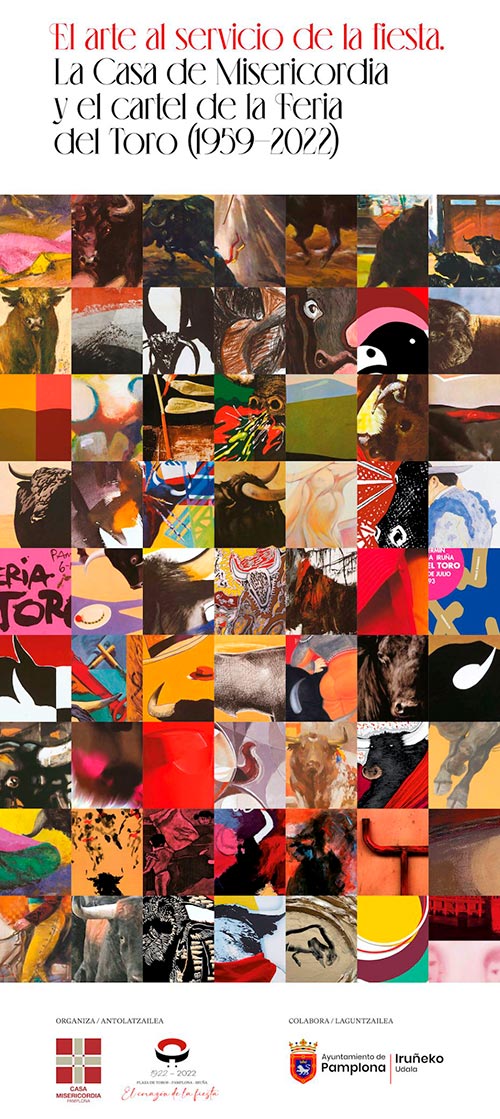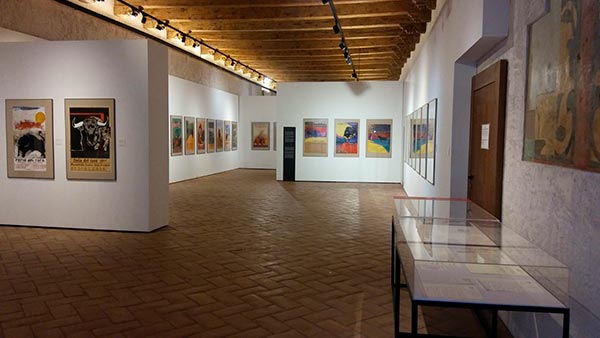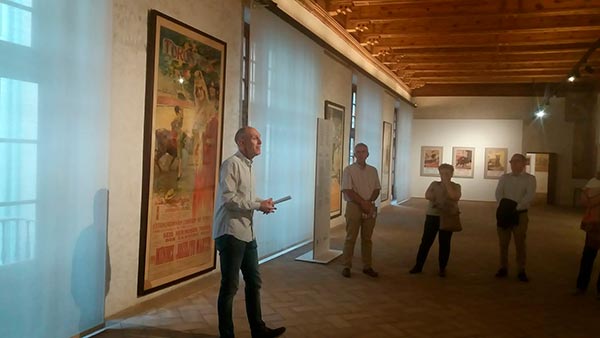August 18
Art at the service of the festival. The Casa de Misericordia and the poster of the Feria del Toro (1959-2022).
José Javier Azanza López
Chair de Patrimonio y Arte Navarro
On the occasion of the Centenary of the place de Toros de Pamplona (1922-2022), Rooms 1 and 2 of the Palacio del Condestable of Pamplona hosted, between June 16 and August 20, 2022, the exhibition El arte al servicio de la fiesta. The Casa de Misericordia and the poster of the Feria del Toro (1959-2022). On Thursday, August 18, the Chair de Patrimonio y Arte Navarro organized a guided visit with Javier Azanza, curator of the same and author of his book-Catalog, which was attended by about thirty people.

Poster announcing the exhibition El arte al servicio de la fiesta. The Casa de Misericordia and the poster of the Feria del Toro (1959-2022).
At visit, Professor Azanza made a tour of the more than 150 pieces that make up the sample , which aims to emphasize two significant aspects. The first is the revaluation of the advertising poster as an exhibition material, along the lines undertaken in recent years by prestigious museums that have incorporated it as an essential part of their museographic narrative, such as the MoMA in New York, the MNAC in Barcelona and the Museo Nacional Centro de Arte Reina Sofía in Madrid. And secondly, to make known and share with the public a part of the rich heritage bequest of the Casa de Misericordia de Pamplona, since all the pieces on display are part of its collection.
As Azanza explained, the exhibition speech is organized around two main elements. First, the bullfighting posters hung on the walls of the galleries and divided into ten sections that make up a unitary story, although some of them work as "micro-exhibitions", such as the tributes to José Antonio Eslava and Ignacio Cía, Juan José Aquerreta's poster for the current year 2022, or the one dedicated to the bullfighting poster in core topic for women with the names of Edith Hultzsch, Francis Bartolozzi, Elena Goñi, Laura Panno and María Franco. The second one takes shape in the showcases of the galleries, with an independent but complementary speech to that of the wall posters, which includes materials such as tickets and hand programs, unpublished sketches by the authors of the poster and correspondence with renowned artists with whom contact was established but who for one reason or another did not sign it, as was the case with Agustín Ibarrola, Francis Bacon and Rafael Ruiz Balerdi.

One of the rooms of the Palacio del Condestable in Pamplona that hosted the exhibition.
The exhibition shows how, from the middle of the 19th century, bullfighting has been present in the posters announcing the San Fermín fiestas, both in scenes linked to the bullfighting in the bullring and in the fast degree program of the running of the bulls. The inauguration in 1922 of the new place de Toros de Pamplona, whose management was left in the hands of the Casa de Misericordia, will be decisive for the future of the poster, because from that moment on, two independent posters were created which, with their specific characteristics, have survived to the present day: the festive poster of the City Hall and the bullfighting poster of the Casa de Misericordia.
This tight historical tour has its culminating point in 1959, when by initiative of Sebastián San Martín, board member of the board of the Casa de Misericordia and member of its Bullfighting Commission, the bullfighting cycle of the San Fermín festivities officially became the Pamplona Bullfighting Fair, giving the leading role to the first class cattle ranches that offered bulls with weight and stamina, such as challenge for the bullfighters who wanted to face them. Since then, the Casa de Misericordia works every year to achieve a plural poster. Avoiding competition and repetition of authors, commissioning renowned firms, freedom of execution, a poster in tune with the times and with the capacity to make an impact, and a certain dose of controversy, these are the premises on which the poster of the Feria del Toro has been based for decades, understood as a patrimonial investment through the creation of a valuable artistic collection with its own stamp. accredited specialization Worthy of mention is the work carried out by the Bullfighting and Poster Commissions, of which Fernando Redón, Fernando Nagore, José M.ª de Andrés, Fernando Pérez Ollo, Pío Guerendiain, Eugenio Salinas, José M.ª framework and Luis Arraiza, among others, have been members, as well as Ignacio Cía, director and cornerstone of the Casa de Misericordia for more than thirty years.
Beyond the binomial text-image as constant elements, although with very personal interpretations and with different Degrees of integration and dialogue between the two, one word defines the essence of the Pamplona bullfighting poster: variety. And it does so at very different levels, from its authors to the techniques used in its execution.
As regards authorship, the Feria del Toro poster features creators from Navarre, Spain and abroad, among which the Colombian Fernando Botero stands out. There is also a notorious variety of languages, ranging from hyperrealist posters to others that verge on abstraction, either because of the interpretative dilemma of their forms or because of the chromatic intensity that destroys them, without forgetting the Dadaist ready-made challenge . No less significant is the iconographic variety, and although the bull is the main protagonist of the poster to announce the Fair, it appears in very different attitudes, lances and scenarios; and sometimes it even becomes invisible to give way to the picador, the silent space of the place, the plastic cape, the irons of the herds or the skin that conceptualizes the festival, to which are added logo-posters in which stroke and color become a true metaphor of the fight in the bullring.
A chromatic variety is also perceptible, since the Feria in red, white and black -the Sanferminero and bullfighting trilogy par excellence- does not close the way to warm colors in its identification with the bullring and the sunny afternoon, nor to the purely bullfighting colors of gold and fuchsia, and even invites the cold ranges of blues, violets and greens, not very much given to the fiesta. And finally, there is a technical variety in the poster originals, offering a wide repertoire in which, although oil painting prevails, tempera, engraving, watercolor, gouache and collage are not ruled out; all this without forgetting that graphic design , photography and sculpture are techniques to which the authors of the poster also resort. Such diversity gives Mecca's bullfighting posters a distinctive and very staff seal that eliminates any hint of monotony and repetition.
At final, the posters for the Pamplona Bullfighting Fair make up an exceptional showcase that invites us to take a look at the universe of the advertising poster, the plastic arts and bullfighting from a multifaceted reality, in which all tastes and sensibilities have a place. This is reflected in the exhibition El arte al servicio de la fiesta. The Casa de Misericordia and the poster of the Bullfighting Fair (1959-2022). It serves as a recognition and tribute to the Casa de Misericordia, whose effort and dedication, even in the difficult moments of the pandemic, have made it possible to put together one of the most valuable bullfighting collections at the height of the Fair it proclaims.

A moment of the visit guided tour with Javier Azanza.
